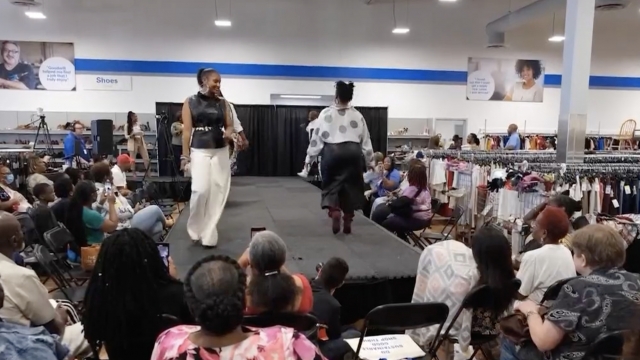Who says protecting the Earth can't be fashionable?
It was evident when models — styled by thrifting — hit the catwalk at an eco-fashion show in Morrow, Georgia, rocking trends without breaking the bank.
"What I love about thrifting is that I am doing my part in supporting my community," Keren Charles said. "I'm also able to save money and still look fabulous."
One stylist and designer, Abraham Corrillo, makes custom pieces from the racks at the North Georgia Goodwill for his Atlanta-based company, Roman Supply Co. What started as a hobby turned into a mission to help reduce the amount of waste in landfills.
"We are taking something that shouldn't be happening and turning it into art, so upcycling and all that," Corrillo said. "One of our core values is, nothing is wasted. Less is more."
Textile waste materials like clothes, bed sheets and tablecloths contain harmful chemicals and dyes. When dumped in landfills, they can release toxic chemicals into the air, soil and water.
According to the United Nations Environment Programme, the fashion industry contributes up to 8% of the world's carbon emissions. Its data also shows textile dyeing is the second largest polluter of water in the world.
"We all wear textiles. It is really, really important that we don't send them to landfills," said Swarupa Ganguli, acting chief of the EPA's Office of Resource Conservation and Recovery.
Ganguli says the agency recognizes the need for producers and customers to embrace a circular economy — an approach that strongly encourages markets to reuse products and minimize waste.
SEE MORE: Fashion designer creates recycled swimsuits for dogs
"You have to think about reuse, you have to think about redesign, you have to think about donation. You have to have a completely different mindset," Ganguli said. "There is a lot that consumers, we as consumers, can do to reduce our imprint on textiles."
That's where thrifting comes in.
Goodwill and other thrift shops accept one man's trash and turn it into another man's treasure. Elaine Armstrong, the vice president of marketing for Goodwill of North Georgia, says the company is a champion for green efforts.
"We are in the business of reuse, and so every time you have an opportunity to reuse something instead of buying it new, we celebrate that," Armstrong said. "So it's a win, win, win all around, and it's also great for the environment."
Thrift shopping experts Keren Charles and Brittany Neal are doing their part. In 2011, Charles founded Thrifting Atlanta — a social network now with over 69,000 members, including bargain shoppers, stylists and resale business owners. And Neal has been passionate about thrifting since she was a little girl. She uses social media to encourage others to adopt sustainable shopping habits.
"I'm that person when they're like, 'Oh, I like your outfit,' I'm like, 'Oh, it's thrifted,'" Neal said. "I make sure I tell people ... I am not ashamed to say I spent $5 on this, like, I'm excited about it because to me, if you're saving and helping the planet, then you're killing two birds with one stone."
Charles feels the same. She helps debunk the negative stereotypes often associated with thrifting.
"Growing up in a single-parent household and back then, thrifting was, you know, people kind of looked down on it because they thought you were homeless, they thought you didn't have any money," Charles said. "Now today, to see that TikTok is exploding, I see young people coming with their friends and to know that I had a part in changing that stereotype. And this fashion show, again, is just letting people know that hey, you can be fashionable. You can be fly. You can save money. You can make an impact on the earth. And it's just a good thing to do."
SEE MORE: Too many kids clothes? Here's one way to cut waste
Trending stories at Scrippsnews.com




